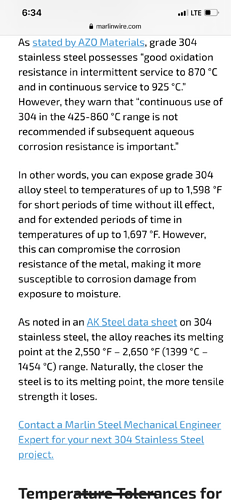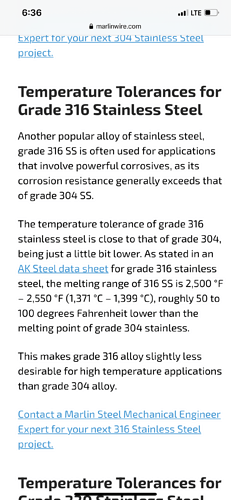So last night our lab was burned down, today I went and salvaged our stainless from our closed loop system, it was all burned up pretty bad. It was definitely subjected to a lot of fire and heat. It’s covered in soot and ash would need to be resurfaced for sure, but is any of it safe to reuse if it was resurfaced or should I just scrap it for the weight of the steel. It’s basically the only thing that was left standing in our facility. I’m assuming it’s all trash at this point but thought it was worth asking as I just bought a brand new 120lb stainless tank and a shotgun condenser from @GreenMachineLabs and it’s kinda butthurting. Thanks for any advice.
I’ve had things burn - not in a major fire, but sections of a lab catching fire, usually from runaway reactions so oxidizers present also.
When this happened to me - I did passivization polishing. This takes the top layer (or more) off your pieces. If you can get them cleaned up AND there’s no specific pitting on the connections or walls. AND you can hold pressure - you can try again.
There’s even companies that will test for you and give you a new boiler certificate (for pressurized tanks and parts) if you want that paperwork warm and fuzzy.
It would have to be quite hot to melt into slag - and it wouldn’t look like the parts you were hoping to find.
At least you have spares if you need them in the future. At best - all the high melting/burning point pieces can continue to be used and you just have to find the lower melting point stuff to replace.
Good luck with your project. Fires are no joke and clean up is hard every time.
Austenitic series stainless should be fine honestly. I’d hydrotest first because it’s easy and better safe than sorry but it shouldn’t be a problem. Biggest issue I’d foresee would be warping causing sealing problems
It’s all still in good shape as far as warping is concerned just need to replace all the valves and hoses and stuff
Put it together and air compress it up to 150 and see if she holds.
Don’t do that. Test with a liquid, not a gas
Presumably unused?!?
Or at least without solvent in it?
I’d certainly run it with ethanol if it cleaned up. Would not run it with hydrocarbons without hydro-testing it up past the oem prv settings.
Nah, it’s just been annealed…
Caveat: I’m a biologist not an engineer. Certifiable & welds is not the same a certified welder.
Elaborate.
We test pressure vessels with water because it’s incompressible and doesn’t store energy. So when the vessel fails, it just squirts a little and you don’t die. 150 psi in a 6" column could very easily kill you. Don’t pressure test with gas unless you have to
Edit: don’t you manufacture extraction equipment @Extractionguy?
I think @TheGratefulPhil posted a couple of 1k word substitutes on the subject, possibly in the failures thread, but I’m on a phone and too lazy to go find them.
Hydro testing should work to jog the all knowing ones memory
What’s a good way to hydro test it?
I would worry about if it had been really hot from the fire, then got hit with water and cooled rapidly and unevenly. That could cause some brittle spots. Could cause gasket surfaces to warp, too.
Easiest way if you don’t have any other gear is to get a manual hydraulic pump like from a harbor freight porta power. Just fill the system up with water trying to exclude as much air as possible. Tee with a gauge and pump it up. ASME hydrotest procedure involves pumping up 20% at a time and holding for 5 minutes but that’s pretty unnecessary at 150 psi.
Haskel actually manufactures a version of their liquid pumps with a handle to manually drive the piston and it’s the bees knees, that’s what we use for our 30ksi hydrotest rig. But any positive displacement pump that will push your HT pressure will work
Edit, here’s a $26 option:
Yeah and besides the original pressure test done to get the very it has been done in every place I’ve ever worked with air.
Maybe don’t ramp it up to 150 off the bat but claiming that something like that would be lethal but using 150 psi in junk Chinese steel isn’t is a bit incongruous.
Start with 50. Ramp it up. Or use water so you don’t die or whatever.
This forum cracks me up. Garage trappers operating in sparked environments and nobody bats an eye but talk about putting compressed air into something deigned to hold that psi and everyone loses their mind lol.
Scooping that up right now thanks a ton
Look man, I’m fine with doing some sketchy hacky shit but I generally disclose it as such. If you’ve ever seen a vessel fail under a pneumatic pressure test, you’ll understand that just because butane explodes doesn’t make it the most dangerous thing we deal with.
And FYI, if you don’t consider equipment that’s literally been through a fire any different that vessels that have been under service, I don’t even know what to say. And ASME does have guidance on returning vessels to service which is what I would consider this
*shed
I wouldnt exactly call this garage trapping, someone set fire to the warehouse next to ours and the fire spread to our facility
I didn’t think he was throwing shade at you. I just took it as a broad statement…
Could be wrong though

